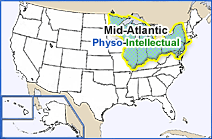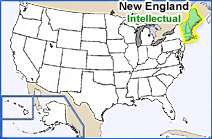

(You can read the Introduction to Kalarhythms for a perspective on GaiaMetrics.)

| Northwest | Emotional | New England | Intellectual | ||||||||||||
| Rocky Mtns. | Intellectual | Mid-Atlantic | Physo-Intellectual | ||||||||||||
| Great Plains | Trirhythmic | South | Physo-Emotional | ||||||||||||
| Southwest | Physical | Caribbean | Physical | ||||||||||||
|
|||||||||||||||
Cultural Regions span the continental United States. Each has its own climate, tradition, accent, economic base, tastes, and aspirations. Each region sees the nation and the world from a different point of view. The character of a region may be more Physical, Emotional, or Intellectual. Texas, for instance, has Physical strength, Northern California has Emotional energy, and New England is an Intellectual hub of the nation. Some regions are noted for combined traits. Cycle-based regions rise and fall with respective Cycles. Population and power centers shift to and from regions as Cycles change. Predominance of regions and their role in the nation therefore alter. Here is a list of seven regions within the contiguous United States and suggestions of their respective aspects.
New England: states identify with Europe and have an established tradition of higher education.
Mid-Atlantic: states see themselves as the industrial capital of a machine age world which produces much of the steel, autos, and machines.
The South: holds deep feelings for an agrarian empire founded on Dixie land.
Southwest: heritage Southwest comes from the "cowboys" who settled in wide-open spaces of the new world.
The Great Northwest: was reached by the most determined of dreamers who migrated across the continent to greener pastures.
The Rocky Mountains: hold virginal lands sparsely populated with people who came from many regions.
Great Plains: farmlands in the Great Plains are a stable national resource from a balanced center.
The Caribbean: extends onto most of the Florida Penisula and it attracts Physically-based people who are drawn to its lush tropical environment.
Alaska is much a part of the Rocky Mountain range that extends to Alaska. The Rocky Mountains are Trirhythmic, and Alaska may also interact with the rest of the US as a Trirhythmic sector.
Hawaii has a heavy tourism trade and profitable coastlines that connect it to the mainland. It also has a significant navy base. In this aspect, it may function as a Physically-based sector that moves with the Physical Cycle of mainland US. This all may be in contrast to many native Hawaiians who have long held to a spiritual connection with nature, and who may have a more Emotionally based tradition. Most of the Islands like Oahu, however, are Physical. Altogether, various regions make up a living nation that is always in motion. We are the United States.
Suggested Area of New England extends north to Canada and east to the Atlantic seaboard. It reaches west to Lake Champlain and to the Housatonic River which runs south along western Massachusetts and Connecticut, to Long Island Sound between Bridgeport and New Haven.

The Mid-Atlantic: Physo-Intellectual
Suggested Area of the Mid-Atlantic reaches north to Canada, and east to Lake Champlain and the Housatonic River. All of Long Island, New York, is included. The region reaches west to the Mississippi River, south to the Ohio River over Kentucky and West Virginia, and southeast to the Potomac River & Chesapeake Bay around Virginia. All of the Great Lakes are in this region.
Suggested Area of the South extends as far north as the Missouri & Mississippi Rivers in Missouri, along the Ohio River, and the Potomac River and Chesapeake Bay. Its eastern border is the Atlantic Ocean, and it runs south to the Gulf of Mexico. A western reach goes to; the Sabine River on the Texas border, the Ozark Mountains in Arkansas, and Missouri, and on up to the Missouri River. These are the Dixie states of the Deep South.
Suggested Area of the Southwest to its northern side includes Death Valley in California & Nevada, the Shivwits (Shebit) Indian Reservation in Utah, the Rio Grande in Colorado, the Canadian River in New Mexico, and the Red River over Texas. It extends east to the Sabine River on the east Texas border, and south to Mexico and the Gulf. A western edge comes to Sierra Nevada Mountains, and the Pacific Coast south of the Santa Clara River (just north of Los Angeles).

The Great Northwest: Emotional
Suggested Area of the Northwest reaches north to Canada, and east to the Cascade and Sierra Nevada Mountains in California. It runs south to the Santa Clara River just north of Los Angeles, and west to the Pacific.

The Rocky Mountains: Trirhythmic
Suggested Area of the Rocky Mountains region goes north through Canada and east through Front Range at the edge of the Plains. Its runs south along Yosemite National Park in California, the Canyonlands National Park in Utah, the Rio Grande in Colorado, and the Canadian River in New Mexico. A western border comes from the Sierra Nevada Mountains. This region is - the Rocky Mountains.
Suggested Area of the Great Plains spread north to Canada, and east to the Ozark Mountains in Missouri and Mississippi River north of St. Louis. It spans south to the Red River, and ends sharply in the west at the base of the Rocky Mountains. This is similar to the boundaries of the Louisiana Purchase in 1803.
Suggested Area of the Caribbean covers the majority of the state of Florida. The northern border of this region extends north to to Tampa Bay on the western border on the Gulf of Mexico, and to south of Jacksonville on the eastern border on the Atlantic seaboard. All of the Florida keys in the south are part of this region that reaches out into the Caribbean Sea and the islands within.
Alaska: Trirhythmic
Hawaii: Physical
<id="enclaves">






